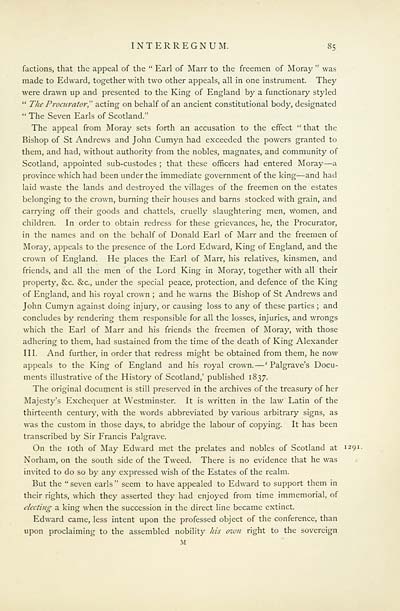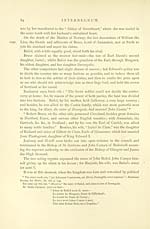Family records of the Bruces and the Cumyns
(97) Page 85
Download files
Complete book:
Individual page:
Thumbnail gallery: Grid view | List view

INTERREGNUM. 85
factions, that the appeal of the " Earl of Marr to the freemen of Moray " was
made to Edward, together with two other appeals, all in one instrument. They
were drawn up and presented to the King of England by a functionary styled
" The Procurator" acting on behalf of an ancient constitutional body, designated
" The Seven Earls of Scotland."
The appeal from Moray sets forth an accusation to the effect " that the
Bishop of St Andrews and John Cumyn had exceeded the powers granted to
them, and had, without authority from the nobles, magnates, and community of
Scotland, appointed sub-custodes ; that these officers had entered Moray — a
province which had been under the immediate government of the king — and had
laid waste the lands and destroyed the villages of the freemen on the estates
belonging to the crown, burning their houses and barns stocked with grain, and
carrying off their goods and chattels, cruelly slaughtering men, women, and
children. In order to obtain redress for these grievances, he, the Procurator,
in the names and on the behalf of Donald Earl of Marr and the freemen of
Moray, appeals to the presence of the Lord Edward, King of England, and the
crown of England. He places the Earl of Marr, his relatives, kinsmen, and
friends, and all the men of the Lord King in Moray, together with all their
property, &c. &c, under the special peace, protection, and defence of the King
of England, and his royal crown ; and he warns the Bishop of St Andrews and
John Cumyn against doing injur}', or causing loss to any of these parties ; and
concludes by rendering them responsible for all the losses, injuries, and wrongs
which the Earl of Marr and his friends the freemen of Moray, with those
adhering to them, had sustained from the time of the death of King Alexander
III. And further, in order that redress might be obtained from them, he now
appeals to the King of England and his royal crown. — ' Palgrave's Docu-
ments illustrative of the History of Scotland,' published 1837.
The original document is still preserved in the archives of the treasury of her
Majesty's Exchequer at Westminster. It is written in the law Latin of the
thirteenth century, with the words abbreviated by various arbitrary signs, as
was the custom in those days, to abridge the labour of copying. It has been
transcribed by Sir Francis Palgrave.
On the 10th of May Edward met the prelates and nobles of Scotland at 1291.
Norham, on the south side of the Tweed. There is no evidence that he was
invited to do so by any expressed wish of the Estates of the realm.
But the " seven earls " seem to have appealed to Edward to support them in
their rights, which they asserted they had enjoyed from time immemorial, of
electing a king when the succession in the direct line became extinct.
Edward came, less intent upon the professed object of the conference, than
upon proclaiming to the assembled nobility his own right to the sovereign
M
factions, that the appeal of the " Earl of Marr to the freemen of Moray " was
made to Edward, together with two other appeals, all in one instrument. They
were drawn up and presented to the King of England by a functionary styled
" The Procurator" acting on behalf of an ancient constitutional body, designated
" The Seven Earls of Scotland."
The appeal from Moray sets forth an accusation to the effect " that the
Bishop of St Andrews and John Cumyn had exceeded the powers granted to
them, and had, without authority from the nobles, magnates, and community of
Scotland, appointed sub-custodes ; that these officers had entered Moray — a
province which had been under the immediate government of the king — and had
laid waste the lands and destroyed the villages of the freemen on the estates
belonging to the crown, burning their houses and barns stocked with grain, and
carrying off their goods and chattels, cruelly slaughtering men, women, and
children. In order to obtain redress for these grievances, he, the Procurator,
in the names and on the behalf of Donald Earl of Marr and the freemen of
Moray, appeals to the presence of the Lord Edward, King of England, and the
crown of England. He places the Earl of Marr, his relatives, kinsmen, and
friends, and all the men of the Lord King in Moray, together with all their
property, &c. &c, under the special peace, protection, and defence of the King
of England, and his royal crown ; and he warns the Bishop of St Andrews and
John Cumyn against doing injur}', or causing loss to any of these parties ; and
concludes by rendering them responsible for all the losses, injuries, and wrongs
which the Earl of Marr and his friends the freemen of Moray, with those
adhering to them, had sustained from the time of the death of King Alexander
III. And further, in order that redress might be obtained from them, he now
appeals to the King of England and his royal crown. — ' Palgrave's Docu-
ments illustrative of the History of Scotland,' published 1837.
The original document is still preserved in the archives of the treasury of her
Majesty's Exchequer at Westminster. It is written in the law Latin of the
thirteenth century, with the words abbreviated by various arbitrary signs, as
was the custom in those days, to abridge the labour of copying. It has been
transcribed by Sir Francis Palgrave.
On the 10th of May Edward met the prelates and nobles of Scotland at 1291.
Norham, on the south side of the Tweed. There is no evidence that he was
invited to do so by any expressed wish of the Estates of the realm.
But the " seven earls " seem to have appealed to Edward to support them in
their rights, which they asserted they had enjoyed from time immemorial, of
electing a king when the succession in the direct line became extinct.
Edward came, less intent upon the professed object of the conference, than
upon proclaiming to the assembled nobility his own right to the sovereign
M
Set display mode to:
![]() Universal Viewer |
Universal Viewer | ![]() Mirador |
Large image | Transcription
Mirador |
Large image | Transcription
Images and transcriptions on this page, including medium image downloads, may be used under the Creative Commons Attribution 4.0 International Licence unless otherwise stated. ![]()
| Histories of Scottish families > Family records of the Bruces and the Cumyns > (97) Page 85 |
|---|
| Permanent URL | https://digital.nls.uk/95072150 |
|---|
| Description | A selection of almost 400 printed items relating to the history of Scottish families, mostly dating from the 19th and early 20th centuries. Includes memoirs, genealogies and clan histories, with a few produced by emigrant families. The earliest family history goes back to AD 916. |
|---|

